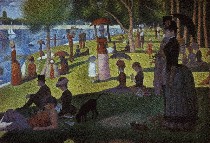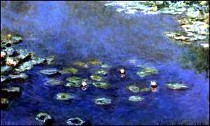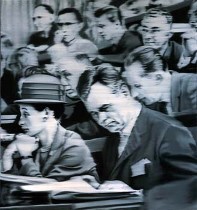 Vis a vis Joe’s blog (Oct. 15), Seurat used blur for his Grand Jatte and Monet for his waterlilies (Oh, I know he was going blind, but still, the work is great).
Vis a vis Joe’s blog (Oct. 15), Seurat used blur for his Grand Jatte and Monet for his waterlilies (Oh, I know he was going blind, but still, the work is great).

Impressionist blur was partially a response to the clarity of camera images. Think of those perfectly detailed daguerrotypes. With cameras providing such clarity in representing the world around us, painting had to go somewhere else, and one of its options was blur.
 And when we moved into tv, video, and computers, where the non-HDTV screen provides its own brand of blur, those screens became a part of our world in a way no still camera image has. So painters began painting about that brave, new, blurry world.
And when we moved into tv, video, and computers, where the non-HDTV screen provides its own brand of blur, those screens became a part of our world in a way no still camera image has. So painters began painting about that brave, new, blurry world.
And even if we think we’re not painting about the world we inhabit, why should we restrict ourselves to hard edges?
 The issue is not blur per se. It’s whether the blur is meaningful. For example, I’m still trying to figure out Gerhard Richter (shown, “Der Kongress”), but while I’m figuring, I find myself pondering the blur and what it’s about. I guess I think Richter’s blur is not gratuitous, although my answer to what it’s about is on the shaky side.
The issue is not blur per se. It’s whether the blur is meaningful. For example, I’m still trying to figure out Gerhard Richter (shown, “Der Kongress”), but while I’m figuring, I find myself pondering the blur and what it’s about. I guess I think Richter’s blur is not gratuitous, although my answer to what it’s about is on the shaky side.
Or to summarize, blur can be beautiful and blur can be smart.
When it’s neither, it’s worth criticizing; same goes for sharp focus.









